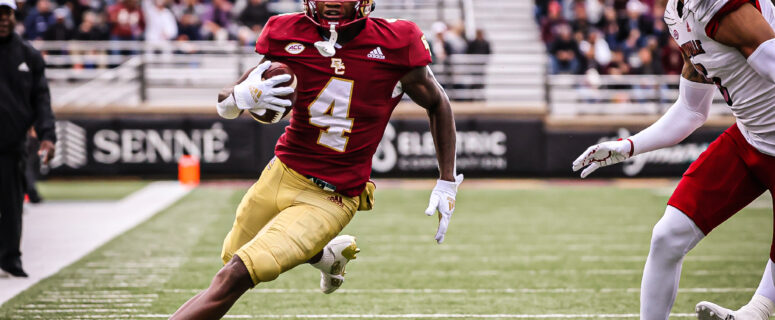KANSAS CITY, Mo. – By the end of Thursday night, Chiefs fans will likely know the identity of the team’s first selection in the 2023 NFL Draft. Who will be the player joining the defending world champions?
Here’s my final take on forecasting where the Chiefs may go with their 10 selections in this year’s draft. No simulator was used for this one but we’re still factoring in common sense when choosing where players may land in the draft.
First round, No. 31 overall
WR Zay Flowers, Boston College
There’s a compelling case to be made for the Chiefs going in a half dozen different directions with this selection, whether it’s trading up or trading back and whether to go receiver, offensive tackle, defensive line or even cornerback. It’s easy to see general manager Brett Veach pursuing all of these angles.
Why Flowers here? He gets the nod for simply being the best player available at a position of need. The top offensive tackles will likely be off the board by this point. The same is true for the defensive line, although there is depth in the second round at that position. The Chiefs have spent time studying Flowers closely, and he famously worked out with Patrick Mahomes and other Chiefs’ pass catchers in Dallas earlier this month.
Flowers is a speedy, productive receiver who can easily step into the roles filled by Tyreek Hill and Mecole Hardman in the Kansas City offense. The knock on Flowers is size – he measures in at 5-foot-9, 182 pounds – but that didn’t stop Hill and Hardman. The Chiefs need depth at receiver, and Flowers should be able to step into a larger role in his first season than Skyy Moore did last year.
If the Chiefs trade up: It means one of the trio of offensive tackles among Georgia’s Broderick Jones, Tennessee’s Darnell Wright or Oklahoma’s Anton Harrison dropped outside the top 20. Jumping inside the top 20 for Jones wouldn’t be too much of a price to pay to shore up protection for Patrick Mahomes and solidify the offensive line. The Chiefs have also shown interest in Ohio State’s Dawand Jones but he’s more suited in the second round.
If the Chiefs trade back: A quarterback remains on the board and a team wants to get that fifth-year option rookie contract for their first-round passer. That’s the ideal scenario for Veach, who could use the opportunity to upgrade their day three selections or stockpile picks for 2024. Dropping back into the early second brings other positions into play such as tight end (Georgia’s Darnell Washington or South Dakota State’s Tucker Kraft), cornerback (Georgia’s Kelee Ringo) or defensive end (Kansas State’s Felix Anudike-Uzomah or Georgia Tech’s Keion White).
Second round, No. 63 overall
DE Derick Hall, Auburn
Hall tallied 16 sacks and 24.5 tackles for a loss in his last two campaigns for the Tigers, illustrating how his quickness and athleticism translate into disrupting the offensive backfield. He’s a bit undersized but Hall can easily fit into a strong three-man rotation on the outside along with Charles Omenihu and George Karlaftis. Defensive line coach Joe Cullen has a reputation for being able to take quick, strong defensive linemen and build them into productive players.
If the Chiefs don’t take a receiver with their first two selections, Rashee Rice from SMU, A.T. Perry from Wake Forest or Mississippi’s Jonathan Mingo are among possible targets here as well.
Third round, No. 95 overall
CB Tre’Vius Hodges-Tomlinson, TCU
Why would the Chiefs select a cornerback on the second night of the draft after selecting four cornerbacks just a year ago? The most compelling reason is the depth of this year’s cornerback class. The thought of finding a speedy (4.41 seconds in the 40-yard dash at the NFL Combine) who broke up 41 passes in 49 games for the Horned Frogs this late in the draft is unusual. While the Chiefs typically covet long, lean corners, it’s hard to ignore Hodges-Tomlinson’s production despite his 5-foot-7, 178-pound frame. He’s built to be a nickel corner, which would allow bigger corners such as L’Jarius Sneed and Trent McDuffie to play on the outside.
And speaking of Sneed, don’t forget he’s also only signed through the 2023 season. The Chiefs have a young group of corners but that also can mean volatility, and Veach strongly believes a team can never have enough guys that can cover receivers downfield.
Fourth round, No. 122 overall
OT Wanya Morris, Oklahoma
There’s much to like about Morris, including his size (6-foot-5, 307 pounds and 35 1/8-inch arms at the NFL Combine). He also started at left tackle for two seasons at Tennessee before transferring to Oklahoma. He started last season at right tackle for the Sooners. That resume would normally put a player higher on the draft board but the knock against Morris is that he’s not fundamentally sound. If offensive line coach Andy Heck can infuse consistency and discipline into Morris, the potential is there for a strong pass protector. Don’t forget that center Creed Humphrey and former left tackle Orlando Brown Jr. also came to the NFL through Oklahoma.
Fourth round, No. 134 overall
TE Josh Whyle, Cincinnati
Have the Chiefs ever gone wrong taking a once-troubled tight end from Cincinnati with ideal measurables and strong testing numbers? The comparison to Travis Kelce falls apart when one looks at Whyle’s production for the Bearcats but there’s still plenty of reason to like Whyle. He showed consistency the last three seasons yet finished his career with only 88 catches for 1,062 yards and 15 touchdowns in 52 games. His production simply hasn’t lined up with his physical skills. He’s already shown newfound maturity, earning captain status least season along with All-AAC first-team honors. Seeing what he can become with Kelce as a mentor would be interesting.
Fifth round, No. 166 overall
OG Anthony Bradford, LSU
The market for interior offensive linemen can be tough to judge and Bradford may be gone before this selection but he fits the Kansas City model as a swing lineman who could in a pinch play all five positions. Even though the Chiefs brought back Nick Allegretti as a backup inside, don’t forget that Joe Thuney is entering his age-30 campaign and has a potential out in his contract following this season.
Sixth round, No. 178 overall
WR Ronnie Bell, Michigan
I’m sold enough on Bell to take him as early as the fourth round but the consensus big board at NFL Mock Draft Database has him ranked No. 187 overall. The local product from Park Hill High School suffered a torn ACL in 2021 and his height (5-foot-11) will concern some. I’ve tagged Bell as the Cadillac version of Albert Wilson – a savvy, tough, competitive receiver who can do a little bit of everything and make the players around him better.
Sixth round, No. 217 overall
DT Brodric Martin, Western Kentucky
Defensive tackle is a high enough need on my board that I wouldn’t blame Veach for addressing the position as early as the first round. The Chiefs still haven’t solidified a complementary starter alongside Chris Jones – and let’s not forget that Jones himself isn’t signed up beyond this season. A redshirt freshman season and COVID rules allowed Martin, who turns 24 next month, to spend six seasons in college, where he played 53 games. Martin earned a top-30 visit with the Chiefs after a standout performance at the East-West Shrine Bowl, the same path that fellow defensive tackle Tershawn Wharton navigated in making it to the NFL.
Seventh round, No. 249 overall
DE B.J. Thompson, Stephen F. Austin
Thompson is another older defensive player in this year’s draft who spent the past six seasons at the collegiately level due to disciplinary issues, a transfer and COVID rules. He played nine games with one start as a true freshman at Baylor in 2017 and tallied 20.5 sacks and 27.5 tackles for loss in 33 games after transferring to Stephen F. Austin. He’s a big body with good speed that needs to put it all together. He’s also the younger brother of Blake Mack, the former Arkansas State tight end who spent training camp with the Chiefs in 2018.
Seventh round, No. 250 overall
WR Shaquan Davis, South Carolina State
Nicknamed “Baby Megatron” for his Calvin Johnson-esque frame (6-foot-4, 216 pounds) and catch radius (an 82 3/8-inch wingspan), Davis is a tempting mold of clay for an NFL team as a developmental project. He proved an explosive target for the Bulldogs, averaging 20.5 yards per catch in his college career with 133 receptions, 2,724 yards and 29 touchdowns. The problem – he also had 30 drops. But he was a latecomer to football in high school and Davis played only 34 games in college. It’s easy to envision a higher ceiling for Davis with room to mature, especially if he focuses on basic ball skills.


